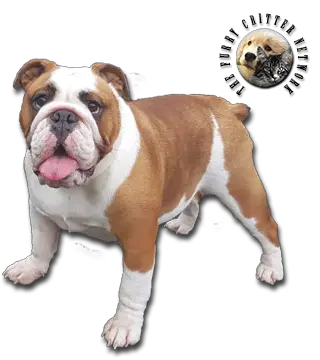Breed Standard
Head: Massive. Short face. Broad skull. Loose, wrinkled skin. Deep stop. Well developed cheeks. Short, broad, upturned muzzle. Broad nostrils. Thick, pendulous flews. Broad, square jaws. Lower jaw protrudes beyond the upper jaw and curves slightly upward.
Ears: Set on high and placed wide apart. Small and thin. Rose ear, in which the ear folds in such a way as to show the inside of the burr.
Eyes: Very wide set. Medium size, round. Very dark color.
Body: Short, well-knit. Very thick neck with dewlap. Shoulders broad and slanting outward. Capacious, round brisket. Ribs well sprung. Elevated, b hindquarters. Belly tucked up. Short, b back. Arched loin
Tail: Set low, round, moderate length. Carried low, hanging straight, not curving up.
Hair: Fine, short, smooth, and thick.
Coat: Uniform color with black mask or muzzle. Uniform colors: red, fawn. Brindle, white, or piebald (white with the above colors). Liver, black, and tan are undesirable.
Size: 30 to 40 cm (12-16 in).
Weight: Dog: 24 to 25 kg (53-55 lb).Bitch: 22 to 23 kg (48.5-51 lb).
History
The designation "bull" was applied because of the dog's use in the sport of bull-baiting. This entailed the setting of dogs (after placing wagers on each dog) onto a tethered bull. The dog that grabbed the bull by the nose and pinned it to the ground would be the victor. It was common for a bull to maim or kill several dogs at such an event, either by goring, tossing, or trampling over them. Over the centuries, dogs used for bull-baiting developed the stocky bodies and massive heads and jaws that typify the breed, as well as a ferocious and savage temperament. Bull-baiting was made illegal in England by the Cruelty to Animals Act 1835. This amended the existing legislation to protect animals from mistreatment and included (as "cattle") snakes, dogs, owls, and donkeys, so that bull and bear baiting, as well as cockfighting, became prohibited. Therefore, the Old English Bulldog had outlived its usefulness in England as a sporting animal and its active or "working" days were numbered. However, emigrants did have a use for such dogs in the New World. In mid-17th century New York, Bulldogs were used as a part of a citywide roundup effort led by Governor Richard Nicolls. Because cornering and leading wild bulls were dangerous, Bulldogs were trained to seize a bull by its nose long enough for a rope to be secured around its neck.
Despite slow maturation so that growing up is rarely achieved by two and a half years, Bulldogs' lives are relatively short. At five to six years of age, they start to show signs of aging.
Though today Bulldogs look tough, they cannot perform the job they were originally created for, as they cannot withstand the rigors of running after and being thrown by a bull, and also cannot grip with such a short muzzle. Although not as physically capable as their ancestors, decreased levels of aggression associated with modern Bulldogs have resulted in a far calmer temperament.
In 1864, a group of bulldog breeders under R. S. Rockstro founded the first Bulldog Club. Three years after it's opening the Club ceased to exist, not having organized a single show. The main achievement of the Rockstro Bulldog Club was a detailed description of the Bulldog.
On 4 April 1873, The Kennel Club was founded, the first in the world dog breeding club dealing with the registration of purebred dogs and dog breeds. Bulldogs were included in the first volume of the Kennel Club Stud Book, which was presented at the Birmingham Show on December 1, 1874.
In March 1875, the third Bulldog Club was founded, which still exists today. The founders of the club collected all available information about the breed and its best representatives and developed a new standard for the English Bulldog, which was published on May 27, 1875. Also, the club held its first show of the breed in 1875. Since 1878, exhibitions of the club were held annually, except during the Second World War. On 17 May 1894, the Bulldog Club was granted the status of a corporation and since then has carried the official name "The Bulldog Club, Inc.", being the oldest mono-breed dog kennel club in the world.
The Bulldog was officially recognized by the American Kennel Club in 1886.
Behavior
The Bulldog is vigorous, courageous, hardy, equable, and dignified. Despite his frightening appearance, he is an affectionate, calm, quiet dog of excellent character. He makes a marvelous playmate for children and develops a strong bond with his owner. Firm training is required.
The Bulldog can adapt to city living provided he exercises regularly. He does not tolerate heat well. Daily brushing is required. Special attention must be given to the folds on his face to ward off possible skin irritation.
Function
Guard Dog, Police Dog, Army Dog, Pet.






